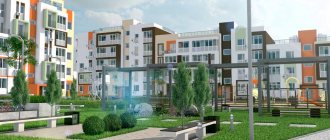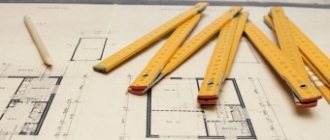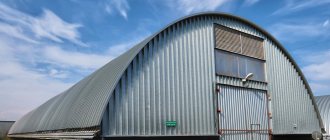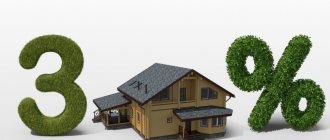The concept of auxiliary structures
Auxiliary structures are temporary buildings that are erected during the construction of the main building. They are auxiliary to the main object. One of their features is temporary. After the objects have served their purpose, they are demolished. These may be the following premises:
- Production.
- Designed for workers' residence.
- Necessary for servicing employees.
- Warehouses.
- Toilets and change houses.
Auxiliary structures are liquidated upon completion of construction. Existing buildings can be adapted for temporary premises. In this case, upon completion of construction, they are restored to their original form.
Do I need to obtain a building permit to erect a structure for auxiliary use?
06/15/2018 Clarification on auxiliary use objects (OVI) on the land plot
FREE CONSULTATION WITH THE CHIEF ENGINEER
Catalog of projects / News
Is a permit required for the construction of a structure located on a plot of land if this structure is an auxiliary facility (for example, an outbuilding, a warehouse)? What are the legal regulations regarding state registration?
Explanation:
- Article 51, clause 17(3) “Town Planning Code of the Russian Federation” dated December 29, 2004 No. 190-FZ (as amended on April 23, 2018): “The issuance of a building permit is not required in the case of: 3) construction on a land plot buildings and structures for auxiliary use";
- From paragraph 10 of Article 4 of the Federal Law of December 30, 2009 N 384-FZ (as amended on July 2, 2013) “Technical Regulations on the Safety of Buildings and Structures”: “Buildings and structures of a reduced level of responsibility include buildings and structures for temporary (seasonal) purposes , as well as buildings and structures for auxiliary use related to the construction or reconstruction of a building or structure...".
Clause 10 of Article 4: “The identification characteristics provided for in Part 1 of this article are indicated: 1) by the developer (customer) - in the assignment for performing engineering surveys for the construction of a building or structure and in the design assignment; 2) by the person preparing the design documentation - in text materials as part of the design documentation, transferred upon completion of construction for storage to the owner of the building or structure";
Based on the social, environmental and economic consequences of damage and destruction of buildings and structures for auxiliary use, these objects are classified as objects of a reduced level (third - in accordance with clause 9.1 of GOST R 54257-2010 "Reliability of building structures and foundations. Basic provisions and requirements") level responsibility;
- Letter of the Ministry of Regional Development of the Russian Federation dated June 25, 2009 No. 19669-IP/08 “On conducting state examination of design documentation for individual capital construction projects”: “Question: it is necessary to conduct state examination in relation to design documentation for a new building of “auxiliary use” located on territory of the site, for example on a building, to place autonomous heat supply sources on an existing site? According to the Ministry of Regional Development of Russia, buildings and structures for auxiliary use should be understood as structures of a reduced level of responsibility in accordance with GOST 27751-88 “Reliability of building structures and foundations.” Such structures include greenhouses, greenhouses, summer pavilions, small warehouses and similar structures. In addition, the criterion for classifying buildings as auxiliary is the presence on the land plot in question of a main building, structure or structure in relation to which the new building or structure performs an auxiliary or service function. According to paragraph 3 of part 17 of Article 51 of the Town Planning Code, in the case of construction of buildings and structures for auxiliary use on a land plot, the issuance of building permits is not required. Taking into account the above, in the opinion of the Ministry of Regional Development of Russia, the design documentation of buildings for auxiliary use is not subject to state examination.”;
- Paragraph 2 of the order of the Ministry of Regional Development of the Russian Federation dated December 30, 2009 No. 624 “On approval of the List of types of work for engineering surveys, for the preparation of design documentation, for construction, reconstruction, and major repairs of capital construction projects that affect the safety of capital construction projects”: the specified List does not include types of work on the preparation of design documentation for objects for which the issuance of a construction permit is not required in accordance with paragraphs 1-4 of part 17 of article 51 of the Town Planning Code of the Russian Federation;
- Determination of the Supreme Arbitration Court of the Russian Federation dated December 3, 2012 No. VAS-15260/12, case No. A51-2472/2012:
“objects that, although firmly connected to the land, do not have an independent functional purpose, are not recognized as real estate, but are considered as an improvement to the land plot for which they were built for cultivation, and therefore follow its fate (Resolution of the Presidium of the Supreme Arbitration Court of the Russian Federation dated January 17, 2012 No. 4777/08, case No. A56-31923/2006
(published on the website of the Supreme Arbitration Court of the Russian Federation on April 13, 2012);
- Regarding state registration:
According to paragraph 1 and paragraph 4 of Article 25 of the Federal Law of July 21, 1997 No. 122-FZ “On state registration of rights to real estate and transactions with it,” the grounds for state registration of ownership of a created JVI are: a declaration of JVI and a title document for the land plot on which the JVI is located.
The declaration form for the real estate property was approved by order of the Ministry of Economic Development of the Russian Federation dated November 3, 2009 No. 447 “On approval of the declaration form for the real estate property”
According to paragraph 12 of the order of Rosregistration dated 07/08/2007 No. 113 “On approval of Methodological Recommendations on the procedure for state registration of rights to created, created, reconstructed real estate objects (does not require state registration)”: a construction permit is not required when submitting documents for state registration JVI property rights (see clause 12).
Thus, we can conclude: When constructing an auxiliary facility, the legislation does not provide for the need for the developer to obtain a construction permit, and, therefore, it does not provide for the developer to obtain permission to put it into operation upon completion of construction work. Ownership of auxiliary facilities is registered in a simplified manner on the basis of a declaration confirming the creation of such facilities and containing their technical description, without submitting permits for construction and subsequent commissioning to the registering authority.
Varieties
Auxiliary institutions, based on the Decree of the State Construction Committee of March 5, 2004 No. 15/1, are divided into titular and non-titled. The first ones are needed to meet the general construction needs listed in the estimate. They are listed in Chapter 8 of the consolidated estimate. The costs for them are included in the estimated cost of constructing the OS. Title buildings include:
- Warehouses with and without heating.
- Temporary warehouses for materials and equipment, various tools.
- Workshops for repair and carpentry work.
- Power plants and boiler houses.
- Water purification facilities.
Is it possible to register the right to construct an auxiliary use?
Non-title objects are needed for the needs of a specific construction project. They are created due to overhead costs for construction and installation. Let's look at examples of non-title buildings:
- Offices and storerooms existing at a construction site.
- Warehouses at the facility.
- Showers and warming rooms for the construction crew.
- Floorings and stairs.
- Auxiliary divorces that will be eliminated after completion of construction.
Auxiliary structures are divided into types depending on their purpose. The type of object determines the way it is reflected.
Administration of Krasnogorsk region
24.03.2018 The “Memory Train” made a stop in the Bryansk region
On March 24, the “Memory Train” arrived in the Bryansk region. The “Train of Memory” campaign has been carried out by the government of the Kaliningrad region since 2007.
23.03.2018 Alexander Bogomaz: “You have to choose: spend budget funds to save lives or renovate the cultural center for 300 million rubles”
On March 23, Governor Alexander Bogomaz held a meeting with representatives of the region’s media.
30.11.2017 Alexander Bogomaz held a working meeting with the management of JSC "
On November 29, Governor Alexander Bogomaz held a meeting on the implementation of an investment project at Unechsky Refractory Metals Plant LLC.
29.11.2017 The Governor held a meeting of the Border Commission of the Bryansk Region
On November 29, a meeting of the Border Commission of the Bryansk Region was held in the Oval Hall of the Government of the Bryansk Region, chaired by Governor Alexander Bogomaz.
29.11.2017 The project “Local House of Culture” is being implemented in the Bryansk region
On November 28, after renovation, the Voronoksky rural House of Culture of the Starodubsky district and the Teplovsky settlement House of Culture of the Karachevsky district were solemnly opened.
29.11.2017 Electronic government services have become even closer and more accessible
The government of the Bryansk region organized on-site registrations of citizens in the Unified Identification and Authentication System on the basis of Bryansk universities.
29.11.2017 Supporting talented youth is a priority for the Government of the Bryansk Region
On November 28, in the Crystal Hall of the Government of the Bryansk Region, a solemn ceremony was held to honor the named scholarship holders of the Bryansk Regional Duma and the Government of the Bryansk Region.
29.11.2017 How to protect your real estate from transactions using fake powers of attorney.
If you are concerned about the real estate properties you own and your rights to real estate are registered in the Unified State Register of Real Estate, you can contact any MFC office.
29.11.2017 In the Bryansk region, the President’s instructions are being implemented within the framework of the National Strategy for Action in the Interests of Children
On November 28, a cluster meeting on the prevention of social orphanhood was held in Pochep, chaired by Deputy Governor Nikolai Shcheglov.
29.11.2017 Electronic government services have become even closer and more accessible
The government of the Bryansk region organized on-site registrations of citizens in the Unified Identification and Authentication System on the basis of Bryansk universities.
29.11.2017 Supporting talented youth is a priority for the Government of the Bryansk Region
On November 28, in the Crystal Hall of the Government of the Bryansk Region, a solemn ceremony was held to honor the named scholarship holders of the Bryansk Regional Duma and the Government of the Bryansk Region.
Alexander Bogomaz: “A specialist who will receive the highest quality knowledge and gain experience through the use of the most advanced technologies - this is our asset!”
On November 27, a meeting of the Council for Science and Scientific Activities under the Governor of the Bryansk Region was held.
A poster competition “Make Your Choice” was held in the Bryansk region
November 27 at the Governor's Palace of Children and Youth Creativity named after. Yu. A. Gagarin held a solemn event to sum up the results of the regional poster competition “Make your choice” among minors.
The Bryansk region took part in the All-Russian meeting on “Formation of a comfortable urban environment”
On November 27, an All-Russian conference call was held on the implementation of programs for creating a comfortable urban environment and major renovations.
Agriculture is a strategically important sector not only for the Bryansk region, but for the entire country
A gala event dedicated to the Day of Agricultural and Processing Industry Workers was held at the Bryansk State Agrarian University.
Residents of the Bryansk region received a concert by Vasily Lanovoy as a gift
On November 27, People's Artist of the USSR, Soviet and Russian theater and film actor Vasily Semenovich Lanovoy came to the Bryansk region at the invitation of Governor Alexander Bogomaz.
A system of territorial public self-government is developing in the Bryansk region
On November 27, at a meeting of the Government of the Bryansk Region, the issue of developing territorial public self-government in the region was discussed.
The road infrastructure of the Bryansk region is ready for work in winter
On November 27, a meeting of the Government of the Bryansk Region was held, chaired by Governor Alexander Bogomaz.
Bryansk Cossacks summed up the results and outlined tasks for 2018
On November 25, the sixth meeting of the reporting circle of the Bryansk Departmental Cossack Society of the Central Cossack Army took place in the city Palace of Culture of the Sovetsky District of Bryansk.
Alexander Bogomaz gave instructions to allocate 9 million rubles for sports uniforms for young Bryansk hockey players
On November 27, Alexander Bogomaz held a working meeting with the Governor’s deputies.
Accounting for auxiliary buildings as fixed assets
Regardless of the type of facility, auxiliary structures will be eliminated after completion of construction work. As a rule, the service life of such objects is 2-3 years. These are short-lived buildings, but they may well be classified as fixed assets. That is, they must be subject to depreciation. Let's consider the grounds for classifying structures as OS:
- The company has ownership rights to the structures.
- Objects are involved in generating income.
- They are not for sale.
- The effective service life exceeds a year.
Important! Accounting for the cost of auxiliary facilities is carried out on the basis of PBU 6/01, and tax accounting is carried out on the basis of Article 256 of the Tax Code of the Russian Federation.
Accounting
The initial cost of auxiliary facilities is reflected in account 08 “Contribution to non-current assets” (subaccount 3 “Construction of fixed assets”). When structures are put into operation, their cost is written off in DT01. Let's look at the accounting entries used:
- DT23 KT10. Write-off of the actual cost of materials that were used during installation.
- DT23 KT70, 69. Transferred salaries and contributions to employees for work on the construction of auxiliary facilities.
- DT08-3 KT23. The share of expenditures of auxiliary production that fall on the construction of temporary facilities.
- DT01 KT08-3. The structure is included in the number of fixed assets.
When auxiliary buildings are added to the balance sheet, this operation must be accompanied by drawing up an act in form No. OS-1a, act of acceptance and transfer of the object. The act in question is relevant for title buildings. If these are non-title buildings, you need to draw up an act of commissioning in form No. KS-8. After all acts are completed, depreciation charges begin. To accrue them, in some cases the company itself sets the useful life. It is determined depending on factors such as:
- Estimated service life.
- Estimated performance.
- Degree of wear.
- Power indicators.
- Other characteristics.
Typically, the useful life is identical to the duration of construction. For depreciation charges, these entries are used: DT 20, 23, 25, 26 KT02.
Features of registration of objects of auxiliary use
I would like to share my position and listen to your opinion on the issue of registering property rights and registering real estate for auxiliary use in the cadastral register.
Today, the issue of state registration of ownership of buildings for auxiliary use and their cadastral registration in different regions of Russia is solved differently. It is especially difficult to register property rights and register such objects on the cadastral register in the city of Moscow, since, firstly, the number of refusal applications from Rosreestr for any reasons in this region is the largest, and this has already become the norm, and secondly, it is Rosreestr in Moscow is ready to carry out the procedure for registering objects only if the applicant provides a “full set” of registration documents, that is, according to the usual scheme for Rosreestr. Moreover, the list of documents required by Rosreestr in this case is significantly larger than the list of documents specified in the Law “On State Registration of Real Estate” and the Town Planning Code of the Russian Federation.
So, in paragraph 3 of part 17 of art. 51 of the Civil Code of the Russian Federation provides that the issuance of a construction permit is not required in the case of construction of buildings and structures for auxiliary use on a land plot.
This rule entails a number of legal consequences:
- Registration of ownership and cadastral registration of such objects should be carried out in the so-called “simplified” procedure, which provides that the owner of the object does not need to obtain permission for construction and commissioning (clause 3, part 17, article 51 of the Civil Code of the Russian Federation , clause 15 of article 55 of the Civil Code of the Russian Federation);
- State cadastral registration and state registration of rights to such an object are carried out on the basis of a technical plan and a title document for the land plot (Clause 10, Article 40 of the Law “On State Registration of Real Estate”);
- The technical plan of such objects is drawn up on the basis of the applicant’s declaration submitted to the relevant government authority (Clause 11, Article 24 of the Law “On State Registration of Real Estate”);
- Based on the above, for the state registration of ownership of an auxiliary use object and its cadastral registration, the applicant is obliged to submit to Rossreestr a technical plan, including a declaration for the property and a title document for the land plot.
This legal position, paradoxically, is generally supported by the Federal Service for State Registration of Cadastre and Cartography itself, set out in a letter dated 03/03/2015 N 14-03050/ [email protected] According to the letter, if the objects of auxiliary use meet the characteristics of the objects real estate (buildings, structures, unfinished construction projects), then they are subject to cadastral registration and their cadastral registration is possible on the basis of a technical plan, prepared, in turn, on the basis of a declaration on the property.
At the same time, in the section “Conclusion of the cadastral engineer” in the technical plan, the rationale for the preparation of the technical plan on the basis of the declaration must be given, in particular, it must be indicated that the property is auxiliary in relation to the main building, structure, or unfinished construction project, due to with which obtaining a construction permit and (or) putting the facility into operation is not required.
At the same time, as practice shows, letters from the Federal Service for State Registration of Cadastre and Cartography are ignored by lower authorities, which is confirmed by numerous refusals of the Moscow Rosreestr Office to register such real estate objects. The basis for refusal is the Applicant’s failure to provide a construction permit and an act of putting the facility into operation, that is, in fact, there are no auxiliary use facilities for Rosreestr.
Separately, I would like to draw attention to the very concept of an object of auxiliary use.
The current Town Planning Code of the Russian Federation does not disclose the concept of an auxiliary use object. According to the letter of the Ministry of Regional Development of the Russian Federation dated June 25, 2009 No. 19669-IP/08 “On conducting state examination of design documentation for individual capital construction projects” (hereinafter referred to as the Letter), buildings and structures for auxiliary use should be understood as buildings of a reduced level of responsibility according to GOST 27751- 88 “Reliability of building structures and foundations.”
In addition, according to the Letter, a building is classified as auxiliary if there is a main building, structure or structure on the land plot, in relation to which the new building or structure performs an auxiliary or service function.
Such buildings may include various objects: greenhouses, electrical substations, hangars, repair shops, summer pavilions and other buildings.
Thus, the legislator identifies two main criteria for classifying objects as objects of auxiliary use:
— reduced level of responsibility;
- presence of a main building on the same plot of land.
In my opinion, there are two more criteria that an auxiliary use object must meet:
1). It must perform a service function in relation to the main structure.
For example, an equipment repair shop on the premises of an enterprise that produces mechanical parts will be an auxiliary building, since it performs a service function for this enterprise, but a hairdresser located in the same building or a grocery store will not perform this function, and, accordingly, the building, with the specified purpose of construction will not be an object of auxiliary use;
2). Operation of the auxiliary building for its intended purpose is possible only in conjunction with the operation of the main building. In other words, the auxiliary building may not have independent engineering communications, which means that in the absence of the main building, the operation of such a facility is not possible.
It should be noted that recently, judicial practice has sided with the applicants and overturned Rosreestr’s decisions to refuse state registration of ownership of auxiliary use objects, reminding Rosreestr that in order to register auxiliary use objects, applicants do not have to provide a permit for construction and commissioning (Decision of the Supreme Court of the Russian Federation dated January 26, 2021 No. 301-KG17-21466, Resolution of the Arbitration Court of the Ural District No. F09-4320/15 in case No. 60-44217/2014, Resolution of the Federal Antimonopoly Service of the Far Eastern District dated January 22, 2013 No. F03- 6096/2012 in case No. A39-6944/2016).
Of course, I would like Rosreestr for Moscow to use this practice, and not force owners of auxiliary use objects to prove their case in court, wasting energy, time and money on this, which they could use for business development.
If anyone has a positive practice in registering objects of auxiliary use in Moscow, I ask you to forward it.
Determination of useful life
When determining the period, it is recommended to use the Classification. The company itself can set a deadline only when there is no auxiliary object in the Classification. The corresponding rule is stipulated by the Letter of the Ministry of Finance dated January 13, 2012 No. 03-03-06/1/12.
Let's look at an example. The canopy belongs to depreciation group 5 (production sites). It belongs to the code 12000 1121. When independently determining the period, you need to use the manufacturer’s recommendations. The establishment procedure is based on paragraph 6 of Article 258 of the Tax Code of the Russian Federation.
Tax accounting
Tax accounting of auxiliary buildings is performed differently. The duration of depreciation is established based on the asset classification groups. The corresponding rule is given in the Letter of the Ministry of Finance dated January 13, 2012 No. 03-03-06/1/12. From a tax accounting point of view, the duration of depreciation will be longer. That is, there will be no depreciation charges. The residual value of the structure is written off after its liquidation has been completed. Write-offs are made to non-operating expenses. All this means that temporary accounting differences arise due to differences in depreciation charges. This rule is stipulated in paragraph 8 of PBU 18/02.
Example
specializes in construction. In 2013, she built a room designed to warm her employees. Construction costs are equal to 200 thousand rubles. The useful life is 24 months. The building belongs to group 10 according to the classification. For tax purposes, the duration of effective operation is 420 months. The depreciation rate for tax accounting is 0.24% (1/24*100%). The depreciation rate for accounting will be 4.17% (1/24*100%). The amount of monthly depreciation charges within the NU is 480 rubles. The amount of accruals within accounting is equal to 8,340 rubles. (200,000*4.17%).
During the construction work, a difference is formed: 8,340 – 480 = 7,860 rubles. The difference provokes the formation of a deferred asset of 1,572 rubles (7,860*20%). The deferred asset must be indicated by this entry: DT09 KT68 (accrual of a tax asset in the amount of 1,572 rubles). Upon completion of construction work, DT09 should contain the entire volume of the tax asset, equal to 37,728 rubles. (1572*24). After the demolition of the auxiliary building, this asset is subject to write-off: DT99 KT09 (write-off of a tax asset in the amount of 37,728 rubles).







